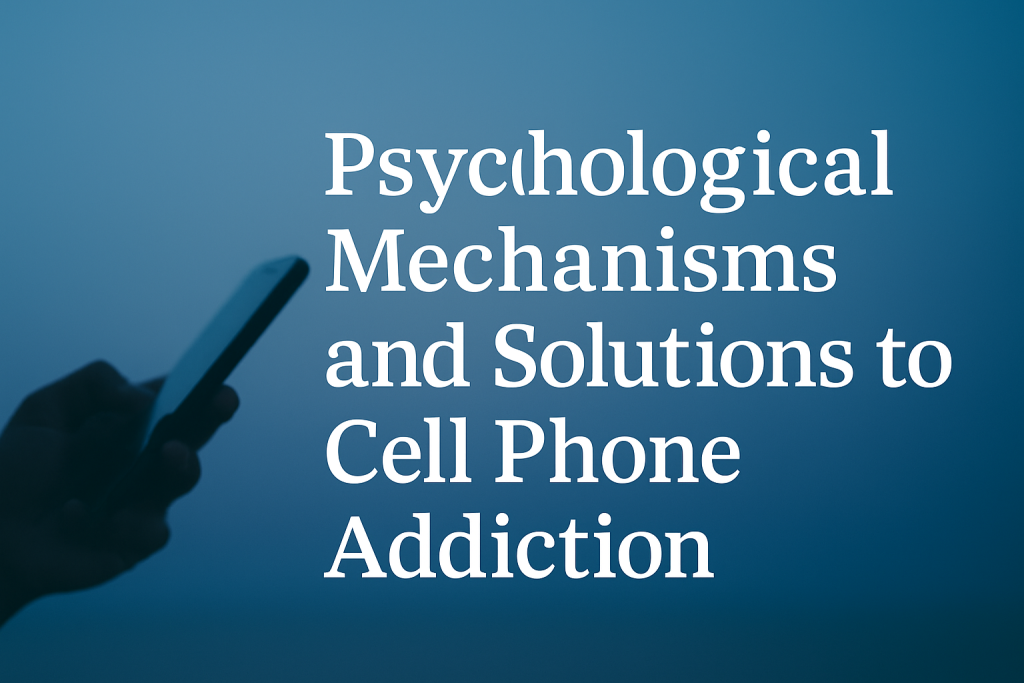Psychological Mechanisms and Solutions to Cell Phone Addiction
Understand your habits — and regain control over your attention and time
Can’t Stop Reaching for Your Phone?
You pick it up to check a message… and 45 minutes later, you’re still scrolling. You feel anxious without it. You check it first thing in the morning and last thing before bed. And maybe deep down, you know it’s affecting your focus, sleep, and well-being — but you’re not sure how to stop.
If this sounds familiar, you’re not alone. Modern smartphones are designed to hook your attention. But breaking the cycle isn’t just about willpower — it’s about understanding the psychological mechanisms and solutions to cell phone addiction.
In this article, we’ll unpack the mental drivers behind phone overuse and explore practical, science-based strategies to help you create a healthier relationship with your device.
—
Understanding the Psychology of Phone Addiction
Dopamine and the Reward Loop
Every time you receive a notification, like, or message, your brain releases dopamine — a feel-good neurotransmitter linked to pleasure and motivation. Over time, your brain begins to crave these micro-rewards, creating a loop of checking, scrolling, and repeating.
Variable Rewards and FOMO
Apps are built on the principle of “intermittent reinforcement” — the same mechanism used in slot machines. You never know when you’ll get a new comment, email, or exciting headline, which keeps you hooked. Combined with the fear of missing out (FOMO), it becomes even harder to put the phone down.
Emotional Avoidance
For many, phones are a way to avoid boredom, loneliness, anxiety, or uncomfortable emotions. Reaching for your device becomes an automatic coping mechanism — even if it ultimately makes those feelings worse.
—
Signs You Might Be Addicted to Your Phone
Behavioral Red Flags
- Checking your phone within seconds of waking up
- Feeling anxious when your phone isn’t nearby
- Difficulty focusing on tasks without checking notifications
- Neglecting sleep, relationships, or responsibilities due to screen time
Emotional Impact
Excessive phone use is often linked to increased anxiety, stress, and low self-esteem — especially when comparing yourself to others on social media.
—
Solutions: How to Break the Cycle
1. Set Clear Tech Boundaries
Designate phone-free times (e.g. during meals, first hour of the morning, one hour before bed). Create “no-phone zones” like the bedroom or dining area. Boundaries help train your brain to expect breaks from stimulation.
2. Use App Limits and Screen Time Tools
Most phones have built-in tools to track and limit usage. Set daily limits for social media or entertainment apps. Try grayscale mode to make the phone less visually stimulating.
3. Practice “Intentional Use”
Before picking up your phone, ask: “What am I doing and why?” Set a purpose (e.g. replying to a message), and when you’re done, put the phone away. This helps break automatic checking habits.
4. Replace, Don’t Just Remove
Instead of scrolling when bored, find healthier substitutes: read, journal, walk, or meditate. Fill those moments with activities that nourish rather than drain you.
5. Embrace Real-World Connection
Make time for face-to-face conversation, nature, and creative flow. Rebuilding real-life engagement helps reduce the emotional dependency on screens.
—
Bonus: Mindful Tech Use Tips
1. Turn Off Non-Essential Notifications
Disable alerts from apps that don’t require immediate attention. This reduces the constant dopamine drip and gives your brain space to reset.
2. Keep Your Phone Out of Reach
Charge it outside the bedroom. Leave it in another room during work blocks. Out of sight often means out of mind — and out of habit.
—
Conclusion: You’re Not Weak — Your Brain Is Wired This Way
Phone addiction isn’t about laziness or lack of discipline. It’s about understanding how your brain responds to modern technology — and learning to shift that relationship with awareness and intention.
The goal isn’t to ditch your phone — it’s to reclaim your attention, your time, and your peace of mind.
✨ Want to start now? Turn off one non-essential notification, and take a 10-minute phone-free walk today. Then subscribe for weekly digital wellness tips and mindful tech habits that actually stick.
